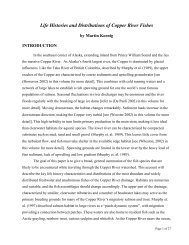Mitigation for the Construction and Operation of Libby Dam
Mitigation for the Construction and Operation of Libby Dam
Mitigation for the Construction and Operation of Libby Dam
Create successful ePaper yourself
Turn your PDF publications into a flip-book with our unique Google optimized e-Paper software.
food sources, as evidenced by <strong>the</strong> loss <strong>of</strong> species <strong>and</strong> total numbers since impoundment<br />
(Voelz <strong>and</strong> Ward 1991). Hauer <strong>and</strong> Stan<strong>for</strong>d (1996) found a significant reduction in insect<br />
production <strong>for</strong> nearly every species <strong>of</strong> insect during a 13-14 year interval in <strong>the</strong> Kootenai<br />
River. These losses can be directly attributed to hydropower operations. Benthic macroinvertebrate<br />
densities are one <strong>of</strong> <strong>the</strong> most important factors influencing growth <strong>and</strong> density <strong>of</strong><br />
trout in <strong>the</strong> Kootenai River (May <strong>and</strong> Huston 1983).<br />
Large gravel deltas have <strong>for</strong>med at <strong>the</strong> mouths <strong>of</strong> several tributaries <strong>of</strong> <strong>the</strong> Kootenai<br />
River (Quartz, O’Brien <strong>and</strong> Pipe Creeks) due to <strong>the</strong> loss <strong>of</strong> high spring flows. These deltas<br />
have reached proportions that are potential barriers to migrating fish such as bull trout,<br />
westslope cutthroat trout, burbot, <strong>and</strong> mountain whitefish at low river levels below <strong>Libby</strong><br />
<strong>Dam</strong> (Graham 1979; Marotz et al. 1988).<br />
A mix <strong>of</strong> mitigation techniques is necessary to <strong>of</strong>fset losses caused by dam<br />
construction <strong>and</strong> operation. A cooperative mitigation <strong>and</strong> implementation plan developed by<br />
Montana Fish, Wildlife & Parks, <strong>the</strong> Kootenai Tribe <strong>of</strong> Idaho <strong>and</strong> <strong>the</strong> Confederated Salish<br />
<strong>and</strong> Kootenai Tribes documents <strong>the</strong> hydropower related losses <strong>and</strong> mitigation actions as<br />
called <strong>for</strong> by <strong>the</strong> Northwest Power Planning Council’s Fish <strong>and</strong> Wildlife Program (MFWP,<br />
CSKT <strong>and</strong> KTOI 1998). This plan identifies several actions that do not require modification<br />
<strong>of</strong> <strong>Dam</strong> operation to be successful. These include aquatic habitat improvement, fish passage<br />
improvements, <strong>of</strong>f-site mitigation, fisheries easements, <strong>and</strong> conservation aquaculture <strong>and</strong><br />
hatchery products.<br />
The <strong>Libby</strong> Creek watershed is <strong>the</strong> second largest tributary between Kootenai Falls<br />
<strong>and</strong> <strong>Libby</strong> <strong>Dam</strong>, <strong>and</strong> has an area <strong>of</strong> 234 square miles. <strong>Libby</strong> Creek provides critical<br />
spawning <strong>and</strong> rearing habitat <strong>and</strong> a migratory corridor <strong>for</strong> <strong>the</strong> threatened bull trout, <strong>and</strong><br />
resident redb<strong>and</strong> trout. The U.S. Fish <strong>and</strong> Wildlife Service’s Bull Trout Recovery Plan<br />
designates <strong>Libby</strong> Creek as part <strong>of</strong> <strong>the</strong> Kootenai River <strong>and</strong> Bull Lake Critical Habitat Sub-<br />
Unit (USFWS 2002). <strong>Libby</strong> Creek has been degraded by past management practices,<br />
including road building, hydraulic <strong>and</strong> dredge mining, <strong>and</strong> riparian logging. These past<br />
activities likely disrupted <strong>the</strong> natural equilibrium within <strong>Libby</strong> Creek that resulted in<br />
accelerated bank erosion along a number <strong>of</strong> me<strong>and</strong>er bends causing channel degradation.<br />
This resulted in poor fish habitat that likely reduced <strong>the</strong> productivity <strong>and</strong> carrying capacity<br />
<strong>for</strong> resident salmonids within <strong>Libby</strong> Creek. Currently <strong>the</strong> stream channel is over-widened<br />
<strong>and</strong> shallow with limited pool habitat (Sato 2000). Many <strong>of</strong> <strong>the</strong> problems related with <strong>the</strong><br />
unstable conditions within <strong>the</strong> <strong>Libby</strong> Creek watershed are a result <strong>of</strong> l<strong>and</strong> management<br />
activities that occurred in <strong>the</strong> upper watershed, <strong>and</strong> <strong>the</strong>re<strong>for</strong>e restoration activities should first<br />
focus on <strong>the</strong> upper watershed (Sato 2000).<br />
Grave Creek is a fourth order tributary to <strong>the</strong> Tobacco River, with a watershed area<br />
<strong>of</strong> approximately 55 square miles. Grave Creek is one <strong>of</strong> <strong>the</strong> most important bull trout<br />
spawning streams in <strong>the</strong> Montana portion <strong>of</strong> <strong>the</strong> Kootenai River (see Chapter 1), <strong>and</strong> has<br />
been designated as critical habitat within <strong>the</strong> U.S. Fish <strong>and</strong> Wildlife Service’s Bull Trout<br />
Recovery Plan (USFWS 2002). Grave Creek is also currently on <strong>the</strong> Montana Water<br />
Quality Limited Segment List as an impaired stream. The State <strong>of</strong> Montana has proposed<br />
122
















